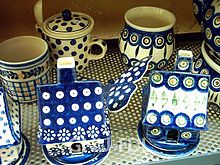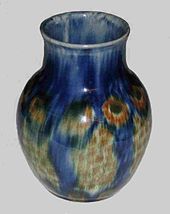Bunzlau ceramics
As a Polish pottery are ceramic products (household utensils, works of art) from the Lower Silesian city Bunzlau (today Polish Bolesławiec ) designated and its surroundings.
History and manufacture
Ceramics production in Bunzlau goes back to the 16th century - richly decorated, diverse utensils and art objects were already being made back then. Later the potters formed a guild, u. a. to ensure the quality. The number of potteries was limited to five. This restriction was lifted in 1762 - however, Bunzlau was already important across Europe at that time.
The great economic importance of Bunzlau ceramics lasted until the end of the Second World War . In addition, it was a style- defining element with its typical decor . A particular advantage of this pottery used to be its fire resistance . This made it possible to make cooking pots and casseroles as well as jugs for keeping drinks warm on the stove top from this almost white to slightly ocher burning shards . Bunzlau ceramics, especially brown stuff, also known as "medical crockery", found widespread use. Not only was it common in Germany, but it was also exported to Scandinavia, Great Britain, the Netherlands, Switzerland and overseas. The outstanding properties of Bunzlau ceramics were resistance to temperature changes and the absence of hairline cracks in the glaze.
The clay mined in the Bunzlauer-Naumburg clay basin was fired at up to 1260 degrees Celsius and was considered to be highly fired earthenware when fired . Despite the high firing temperature, the body was not densely sintered , so it was still somewhat porous and could therefore withstand temperature changes. The melted clay glaze - originally pure, low-melting, red-brown clay - made the ceramic impervious to all types of liquids. While a lot of lead oxide was still used for a long time in other European pottery areas, the early lead-free glazes used made a significant contribution to the great success of Bunzlau ceramics.
However, with the introduction of enamelled cast iron and sheet steel pots and finally of such equipment made of aluminum at the beginning of the 20th century, the advantage of fire resistance largely lost its importance. Many other things became superfluous as a result of new forms of food supply: storage vessels lost their importance due to better supply routes, especially in cities. Food carriers for the farm and factory workers were finally no longer needed.
Innovations in the pottery trade were promoted by the Royal Ceramic Technical School , founded in Bunzlau in 1897 based on the Austrian model, and after 1922 the State Ceramic Technical School . Until recently, in addition to industrial production in Bunzlau and the surrounding area, there were a large number of family-owned handpotters that turned on the disc or cast in plaster molds. In direct competition with the pottery in the city of Bunzlau were the workshops in the neighborhood that were founded by potters who had left, for example in Naumburg am Queis , Tillendorf and Ullersdorf . The success of Bunzlau ceramics led to imitations in other pottery places, which were then also sold under this generic name. The potters in Bunzlau and the surrounding area therefore tried to protect themselves with the brand stamp “Original Bunzlau”. Manufacturer's brands are preferably found on the more industrially manufactured products; they are absent on older pottery, especially those that are turned on a potter's wheel. Due to the Second World War, production came to an abrupt end. However, Reinhold & Co. was able to resume operations in August 1946 and operated under the name of Bunzlauer Töpfer- und Keramikwerke .
Old Bunzlau crockery can still be found in many households and at flea markets and auctions. Well-known potteries were Gleisberg , August Hude , Julius Paul and Son , Hugo Reinhold & Co and Edwin Werner .
In Bunzlau, the clay pipe and fireclay factory Hoffmann & Co produced ceramics for commercial use a. a. in pottery, but z. B. also in manger . Such ceramic products are not referred to as Bunzlau ceramics.
Forms and uses
Bunzlau ceramics were used on the one hand for kitchen utensils and crockery, including for cooking pots, baking molds, saucepans, jugs, bowls, milk satellites to separate the cream, food carriers and tableware. The latter included the large cups ("Tippel") and smaller pots without handles ("Krausen"), for example for honey or jam, as typical Silesian products. The mustard pots and ginger pots are also known. On the other hand, decorative ceramics were created in Bunzlau. As early as the 17th century, representative vessels with pewter mounts and elaborate applications were made. Later there were flower vases, bowls (open or with lids), ashtrays and candlesticks.
Development of the decor
The decorating techniques described below were dominant. Elaborate methods such as relief decoration or applied decoration have a high artistic value, but were not very widespread and can therefore be neglected here.
Clay glaze
The clay glaze was the oldest technique; it was used - at least for storage vessels - until 1945. It gives a strong brown tone that stands out due to its special sheen. In 1936, the Bunzlau Ceramics School revived the clay glaze under the name Aktion Bunzlauer Braunzeug in order to promote the old craft traditions under National Socialist influence. The resulting tableware, decorated with white clay appliqués, had great success until production was discontinued at the beginning of the war. A viscous white glaze or an easily melting white engobe was painted onto the raw clay glaze surface and easily fused with it. This technique led to soft, slightly fuzzy contours of the decors.
Sponge decor / sponge decor
In the last third of the 19th century, the sponge decor (also known as sponge decor ) became increasingly popular for table and household dishes . For this purpose , small colored ornaments are stamped on with suitably cut sponges - the elephant ear sponge . Concentric swabs in different colors were very popular, the peacock's eyes, which were supplemented by engobe painting, and more rarely by brush painting. Bunzlau ceramics with this decoration received the gold medal for cadmium- and lead-free dishes at the World Exhibition in London in 1905 .
Spray decor
Spray decoration only became successful as a decoration technique in Bunzlau in the twenties of the 20th century with the development of elastic stencils . The turn to the "New Objectivity" in industrial production encouraged the use of spraying technology, which also gained popularity with the advent of the Art Deco style.
More decorative glazes
- Engobe painting: colored line ornaments, points or inscriptions from a thick suspension of glaze mass ( slip ) were applied using a spray balloon .
- Brush painting: Here the paint liquid was thinner in consistency, the ornaments applied with a brush are more flat; motifs from the plant world are often found.
- Marbling: A different colored engobe of the same consistency was applied to the vessels covered with a fresh basic gobe using a watering can or with the help of individual animal hairs, and corresponding color gradients were then created by shaking or swiveling movements. In another technique, small engobes of different colors were dripped onto the surface of a container with the basic robe and then the vessel to be decorated was quickly dipped in with a rotating movement.
- Running glaze : With this technique, the glaze was applied in multiple colors as a stencil-free spray decoration or with a brush. The viscosity of the glaze and a firing process at an elevated temperature lead to a typical pattern of the decoration which is often surprisingly beautiful.
Bunzlau ceramics after the Second World War
Some Bunzlau potters, especially smaller family businesses, resumed their activities after the expulsion in 1945. In such cases, the potters settled in places where the pottery trade was already located due to suitable clay deposits. Many continued the Bunzlau sponge decor; however, there was a lack of suitable sponges in the years after the war. Sponge decor or spray decor were or are made in Fredelsloh in Solling, Höhr-Grenzhausen and Siershahn in the Westerwald, in Ludwigsburg , Marktheidenfeld and Leutershausen . This type of decoration is also used in pottery in Upper Lusatia to this day.
Polish manufacturers are also continuing this art of pottery from the previous century. Bunzlau ceramics are no longer turned on the potter's wheel, but the ceramics are made according to old forms and by hand. The old well-known decors such as the peacock's eye , but also new decors are produced. There are now several factories in today's Bolesławiec that specialize in the production of Bunzlau ceramics. Due to the high quality, the Bunzlau ceramics are experiencing a new bloom: They are dishwasher and microwave safe and fire-proof.
literature
- Barbara Glinkowska, Stefan Krabath (et al.): Großalmerode in the Werra-Meißner district, Germany In: U źródeł Bołeslawieckiej ceramiki - From the beginnings of Bunzlau ceramics - Finds from the 15th to 17th centuries Century from a Central European pottery center - exhibition in the Silesian Museum in Görlitz, Görlitz 2012, pp. 280–281 (catalog also with ill. Großalmeroder Keramik)
- Konrad Spindler : Bunzlauer ceramics in the Germanisches Nationalmuseum - inventory catalog , the volume was published for the exhibition "Guter Ton aus Bunzlau - Bunzlauer dishes in the Germanisches Nationalmuseum" (September 30, 2004 - February 27, 2005), Verlag des Germanisches Nationalmuseums, Nuremberg 2004, ISBN 3 -936688-03-6 .
- Konrad Spindler (ed.): Bunzlauer ceramics. The fine stoneware factory Julius Paul and Son in Bunzlau (1893 - 1945) . Vol. 1–2, Nearchos, University of Innsbruck 2002, ISBN 3-89790-168-4 .
- Werner Endres, et al. : Contributions to Bunzlau ceramics . Edited by Konrad Spindler, Institute for Prehistory and Early History Innsbruck, Nearchos 5 series, University bookstore Golf Verlag, Innsbruck 1997, ISBN 3-900773-17-3 .
- Maria Starzewska, Teresa Wolanin: Artystyczna Kamionka Bolesławiecka . Catalog Zbiorów Muzeum Narodowego we Wrocławiu i Muzeum Ceramiki w Bolesławcu, Wrocław 1995.
- Heidi Müller , Ekkehard and Inge Lippert: Bunzlau crockery - consumer goods between craft and industry . Museum for German Folklore SMPK, Berlin, July 13, 1986 to May 17, 1987; Hetjens Museum, German Ceramics Museum, Düsseldorf, June 21 - August 30, 1987; Altonaer Museum in Hamburg, North German State Museum, Hamburg, 7.10.1987-27.3.1988. Berlin 1986, ISBN 3-496-01036-3 . (Writings of the Museum für Deutsche Volkskunde Berlin, Vol. 14).
- Mechthild Wiswe : Folk ceramics from Sommersdorf and Sommerschenburg, two villages in the Magdeburg woodland . In: Braunschweigische Heimat, magazine for nature and homeland care, regional and folklore of Eastern Falcons . Booklet accompanying a special exhibition in the Braunschweigisches Landesmuseum December 1980, published by the Braunschweigischer Landesverein für Heimatschutz, 66th year, issue 4.
- Kristine Späth: Pottery in Silesia, Bunzlau and the surrounding area . Delp'sche Verlagsbuchhandlung, Munich 1979, ISBN 3-7689-0172-6 .
- Josef Horschik: stoneware . Ebeling Verlag, Wiesbaden 1978, ISBN 3-364-00208-8 .
- Konrad Strauss: Bunzlau pottery, their history and products . In: Ceramic Friends of Switzerland , Bulletin No. 82, Swiss National Museum Editor, Zurich June 1971.
- Rudolf Weinhold : Pottery in Upper Lusatia . Akademie-Verlag, Berlin 1958.





